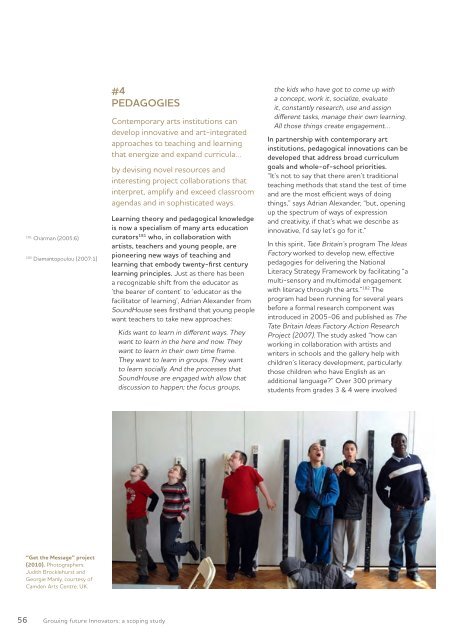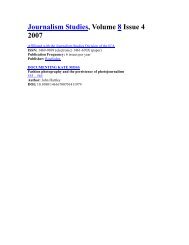GrowinG Future innovators - ARC Centre of Excellence for Creative ...
GrowinG Future innovators - ARC Centre of Excellence for Creative ...
GrowinG Future innovators - ARC Centre of Excellence for Creative ...
You also want an ePaper? Increase the reach of your titles
YUMPU automatically turns print PDFs into web optimized ePapers that Google loves.
56<br />
181 Charman (2005:6)<br />
182 Diamantopoulou (2007:1)<br />
“Get the Message” project<br />
(2010). Photographers:<br />
Judith Brocklehurst and<br />
Georgie Manly, courtesy <strong>of</strong><br />
Camden Arts <strong>Centre</strong>, UK.<br />
#4<br />
PEDAGOGIES<br />
Growing future Innovators: a scoping study<br />
Contemporary arts institutions can<br />
develop innovative and art-integrated<br />
approaches to teaching and learning<br />
that energize and expand curricula…<br />
by devising novel resources and<br />
interesting project collaborations that<br />
interpret, amplify and exceed classroom<br />
agendas and in sophisticated ways.<br />
Learning theory and pedagogical knowledge<br />
is now a specialism <strong>of</strong> many arts education<br />
curators 181 who, in collaboration with<br />
artists, teachers and young people, are<br />
pioneering new ways <strong>of</strong> teaching and<br />
learning that embody twenty-first century<br />
learning principles. Just as there has been<br />
a recognizable shift from the educator as<br />
‘the bearer <strong>of</strong> content’ to ‘educator as the<br />
facilitator <strong>of</strong> learning’, Adrian Alexander from<br />
SoundHouse sees firsthand that young people<br />
want teachers to take new approaches:<br />
Kids want to learn in different ways. They<br />
want to learn in the here and now. They<br />
want to learn in their own time frame.<br />
They want to learn in groups. They want<br />
to learn socially. And the processes that<br />
SoundHouse are engaged with allow that<br />
discussion to happen; the focus groups,<br />
the kids who have got to come up with<br />
a concept, work it, socialize, evaluate<br />
it, constantly research, use and assign<br />
different tasks, manage their own learning.<br />
All those things create engagement…<br />
In partnership with contemporary art<br />
institutions, pedagogical innovations can be<br />
developed that address broad curriculum<br />
goals and whole-<strong>of</strong>-school priorities.<br />
“It’s not to say that there aren’t traditional<br />
teaching methods that stand the test <strong>of</strong> time<br />
and are the most efficient ways <strong>of</strong> doing<br />
things,” says Adrian Alexander, “but, opening<br />
up the spectrum <strong>of</strong> ways <strong>of</strong> expression<br />
and creativity, if that’s what we describe as<br />
innovative, I’d say let’s go <strong>for</strong> it.”<br />
In this spirit, Tate Britain’s program The Ideas<br />
Factory worked to develop new, effective<br />
pedagogies <strong>for</strong> delivering the National<br />
Literacy Strategy Framework by facilitating “a<br />
multi-sensory and multimodal engagement<br />
with literacy through the arts.” 182 The<br />
program had been running <strong>for</strong> several years<br />
be<strong>for</strong>e a <strong>for</strong>mal research component was<br />
introduced in 2005-06 and published as The<br />
Tate Britain Ideas Factory Action Research<br />
Project (2007). The study asked “how can<br />
working in collaboration with artists and<br />
writers in schools and the gallery help with<br />
children’s literacy development, particularly<br />
those children who have English as an<br />
additional language?” Over 300 primary<br />
students from grades 3 & 4 were involved




![Plebiscite (Riegert chapter) revised FINAL [Feb 14].pdf](https://img.yumpu.com/8710373/1/190x245/plebiscite-riegert-chapter-revised-final-feb-14pdf.jpg?quality=85)